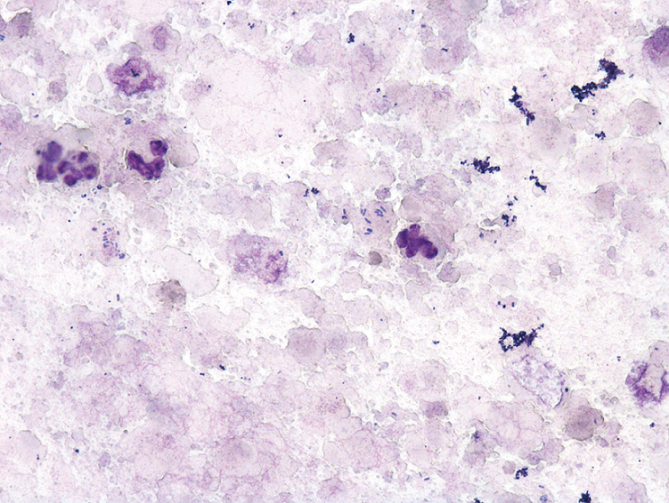Difference between revisions of "Canine Infectious Diseases: Self-Assessment Color Review, Q&A 04"
Jump to navigation
Jump to search
(No difference)
| |
Latest revision as of 09:42, 26 November 2018
| This question was provided by CRC Press. See more case-based flashcards |

|
Student tip: This case is an interesting diagnosis and work-up. |
Case 04 is the same dog as in Cases 02 and 03. Cytologic examination of the aspirated bile showed neutrophilic inflammation and the presence of bacteria (see Image). On bile culture, significant growth of Escherichia coli was noted.
| Question | Answer | Article | |
| What are the most common bacterial species involved in bacterial cholangitis and, therefore, what antimicrobial would you choose empirically while the results of culture and susceptibility are pending? | A study of 190 dogs with a positive culture of bile, gallbladder, or liver showed that Escherichia coli, Enterococcus spp., Bacteroides spp., Streptococcus spp., and Clostridium spp. were the most common bacteria isolated. More than 80% of Enterobacteriaceae were susceptible to ciprofloxacin or aminoglycosides, whereas only 30–67% were susceptible to first-generation aminopenicillins and cephalosporins. In this dog, intravenous antibiotics are indicated. Fluoroquinolones are a reasonable first choice, because Enterobacteriaceae susceptible to this group of antibiotics are most frequently isolated. Anaerobic bacteria might also be involved, and thus fluoroquinolones should be combined with metronidazole, clindamycin, and/or a beta-lactam/beta-lactamase inhibitor combination such as ampicillin/sulbactam.
|
Link to Article | |
| Are bacterial infections of the hepatobiliary system common in dogs? | In contrast to cats, in which neutrophilic cholangitis is common, bacterial cholangitis is uncommon in dogs.
|
Link to Article | |
| What predisposing factors contribute to ascending bacterial cholangitis? | Predisposing factors in dogs include biliary stones, inflammatory bowel disease (causing sphincter odi incompetence), pancreatitis, vomiting, and immunosuppression. In this dog, a foreign body was suspected on the basis of the results of an upper gastrointestinal tract contrast study and was confirmed using ultrasound. The foreign body was surgically removed.
|
Link to Article | |
| For how long would you continue antimicrobial treatment? | Based on reports of successful treatment of bacterial cholangitis with long-term follow-up, antibiotics should be continued for 2–4 weeks. The dog recovered uneventfully with pradofloxacin selected as the outpatient antibiotic in this case (pradofloxacin is a new fluoroquinolone that is licensed for use in dogs, but so far only in Europe).
|
Link to Article | |
To purchase the full text with your 20% discount, go to the CRC Press Veterinary website and use code VET18.
